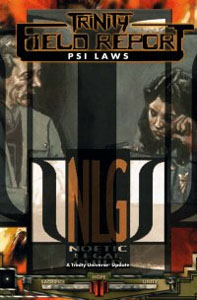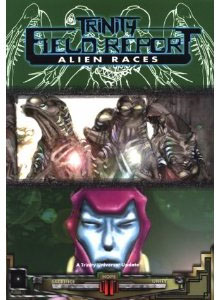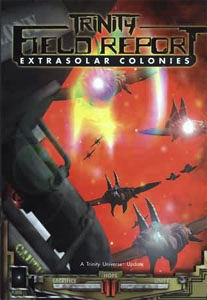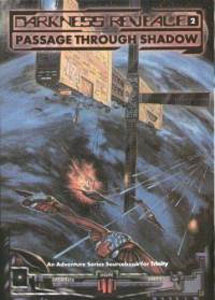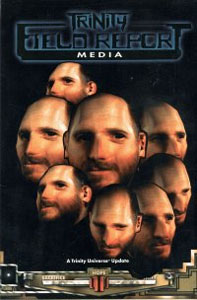 In my last review of a Field Report — Psi Laws — I pointed out that the great strength of the format was that it allowed Andrew Bates (Trinity’s creator and line developer) to explore themes and concepts which would otherwise be difficult to do in a standard roleplaying sourcebook. Psi Laws was an excellent example of this. So is the Media report.
In my last review of a Field Report — Psi Laws — I pointed out that the great strength of the format was that it allowed Andrew Bates (Trinity’s creator and line developer) to explore themes and concepts which would otherwise be difficult to do in a standard roleplaying sourcebook. Psi Laws was an excellent example of this. So is the Media report.
Rick Jones takes a very good look at one possible course of evolution from the modern media of today to the future media of tomorrow – blending film, television, and the internet (along with a number of others) into a future of a fragmented OpNet and “the miracle of holovision”. The use of the Field Report motif of the product being a “real” Aeon Trinity field report to its field agents allows Jones to take a very subtle approach to what is far too often treated in a cavalier manner. As a result you end up truly believing that the pastiche of media forces he describes could actually exist.
If nothing else this product is a useful addition to your Trinity collection because it helps you make greater sense out of other Trinity products. That seems a little odd at first, but you need to realize that significant portions of most Trinity products consists of media excerpts of one variety or another (artifact storytelling is the technical term for this) – hence the Media field report serves as a guide to those excerpts.
The one major drawback of the Media field report, however, is that it pulls a Verhoeven. Paul Verhoeven is the director of Robocop, Total Recall, and Starship Troopers (among others). Anyone who has seen these films know that they hold a single trait in common: They all use fictional commercials and television programs as means of advancing a story or introducing a setting. The thing all of these fictional programs have in common is that they’re all cheesy – looking more like paraodies of television commercials rather than actual television commercials. Although some of the visual elements of programs covered in the Media field report are actually quite good (Retrospective with Warren Shaw — a news program whose dead host was replaced with a sim of himself — is a good example), others are quite pathetic (Tuna Sandwich and Jake Danger: Aberrant Hunter). This is a prime example of how poor visual presentation can spoil an otherwise decent product. Since the book deals with the media of the twenty-third century the fact that that media comes off looking hokey cheapens the whole thing.
In any case, although this Field Report doesn’t quite live up to the reputation of the others so far due to its poor visual performance, it is still worth $5 – particularly for Jones’ excellent work. It would take a lot more than this type of minor foul-up to make these products worth less than their dollar value.
(For those of you who are following the developing meta-story for Trinity check out the sidebar on pg. 15. It kinda ruins the mystique of this being an “actual” field report – but that’s a pretty juicy tidbit they’ve decided to give us.)
Style: 4
Substance: 5
Author: Rick Jones
Company/Publisher: White Wolf
Cost: $4.95
Page count: 25
ISBN: 1-56504-771-0
Originally Posted: 1999/04/26
For an explanation of where these reviews came from and why you can no longer find them at RPGNet, click here.

